The Patient Experience and Partnering in Care
VerifiedAdded on 2023/06/04
|9
|2156
|74
AI Summary
This essay reflects on the falls experience of the patient and e-health records in care. It describes the experiences of the 75-year-old patient using Gibb's reflective cycle and explores the values and beliefs towards falls and the prevention mechanisms.
Contribute Materials
Your contribution can guide someone’s learning journey. Share your
documents today.
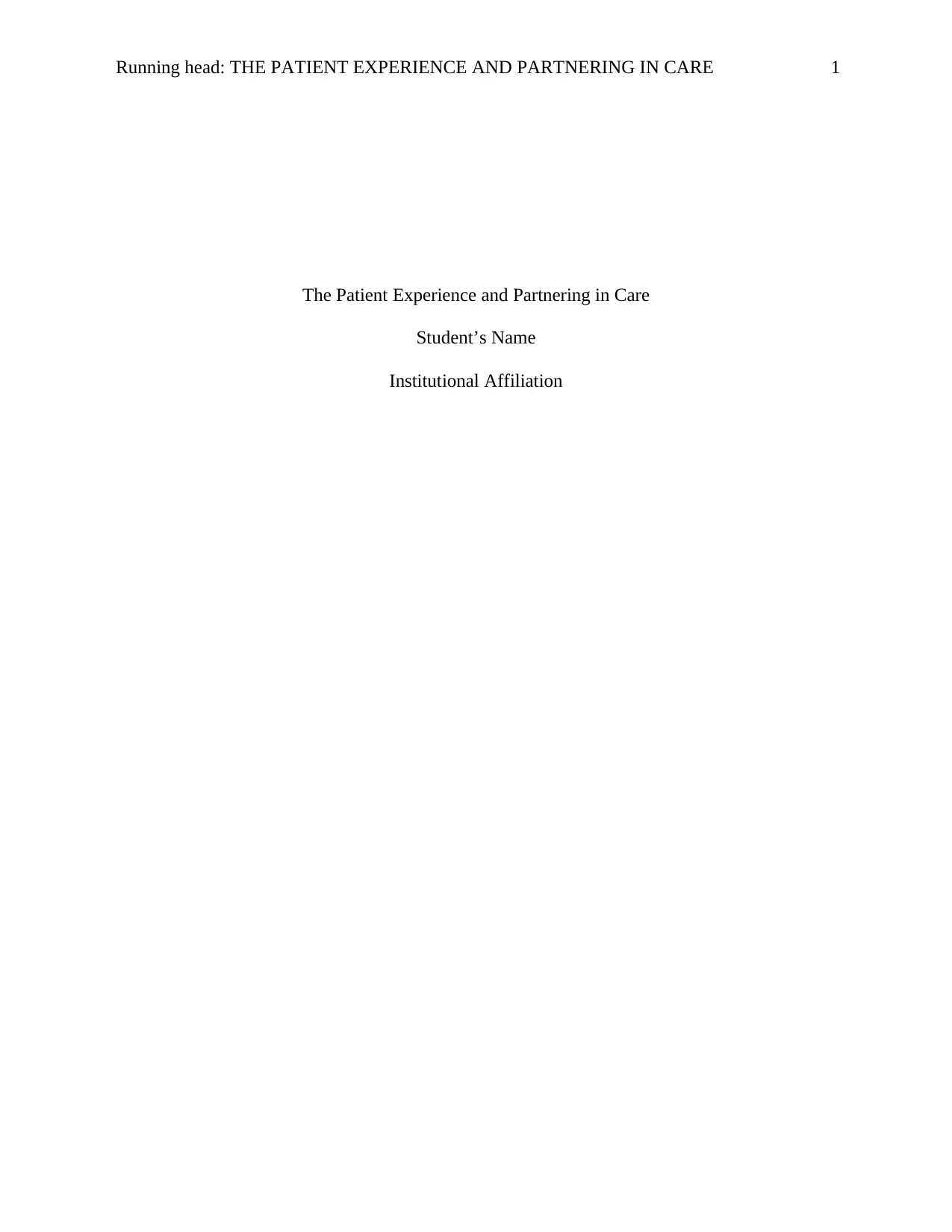
Running head: THE PATIENT EXPERIENCE AND PARTNERING IN CARE 1
The Patient Experience and Partnering in Care
Student’s Name
Institutional Affiliation
The Patient Experience and Partnering in Care
Student’s Name
Institutional Affiliation
Secure Best Marks with AI Grader
Need help grading? Try our AI Grader for instant feedback on your assignments.
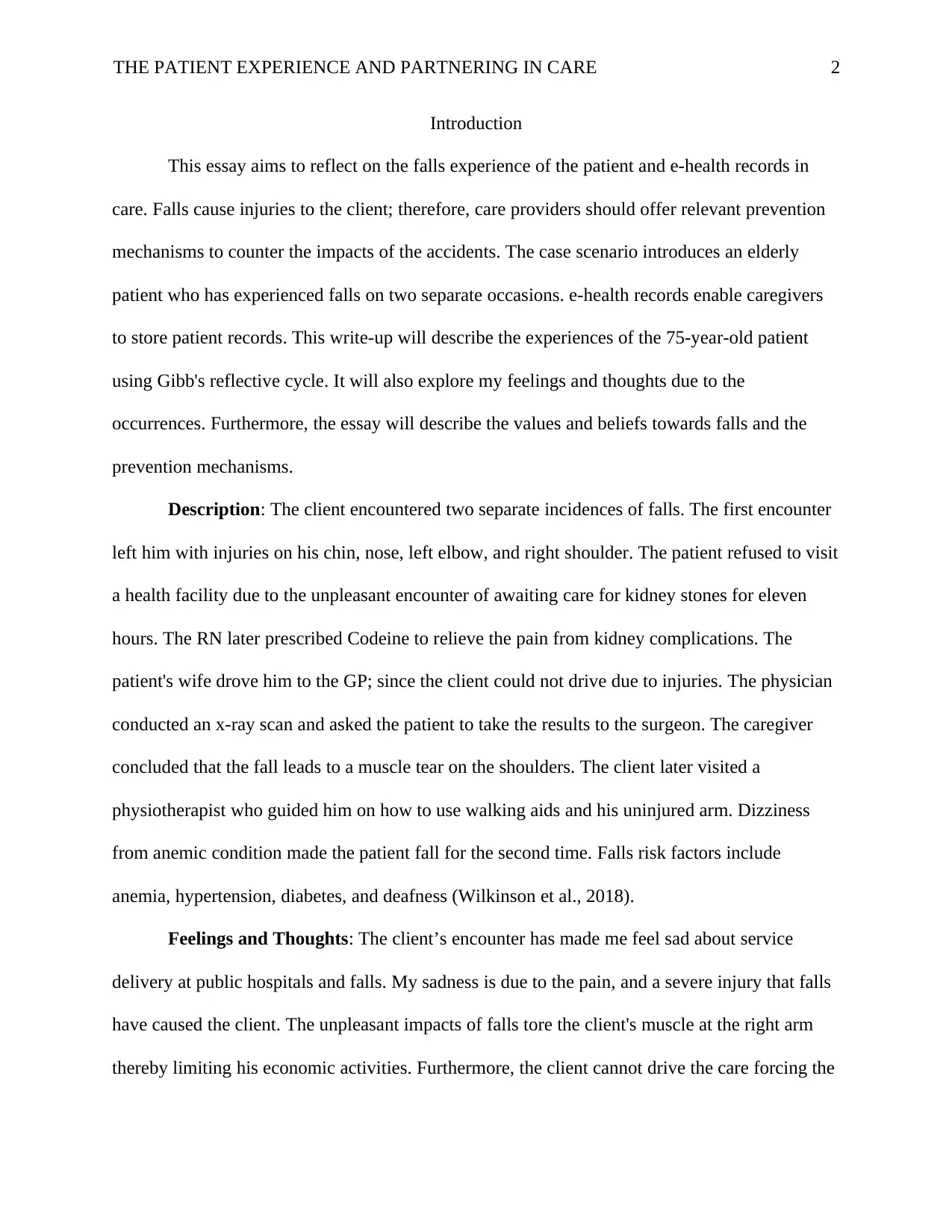
THE PATIENT EXPERIENCE AND PARTNERING IN CARE 2
Introduction
This essay aims to reflect on the falls experience of the patient and e-health records in
care. Falls cause injuries to the client; therefore, care providers should offer relevant prevention
mechanisms to counter the impacts of the accidents. The case scenario introduces an elderly
patient who has experienced falls on two separate occasions. e-health records enable caregivers
to store patient records. This write-up will describe the experiences of the 75-year-old patient
using Gibb's reflective cycle. It will also explore my feelings and thoughts due to the
occurrences. Furthermore, the essay will describe the values and beliefs towards falls and the
prevention mechanisms.
Description: The client encountered two separate incidences of falls. The first encounter
left him with injuries on his chin, nose, left elbow, and right shoulder. The patient refused to visit
a health facility due to the unpleasant encounter of awaiting care for kidney stones for eleven
hours. The RN later prescribed Codeine to relieve the pain from kidney complications. The
patient's wife drove him to the GP; since the client could not drive due to injuries. The physician
conducted an x-ray scan and asked the patient to take the results to the surgeon. The caregiver
concluded that the fall leads to a muscle tear on the shoulders. The client later visited a
physiotherapist who guided him on how to use walking aids and his uninjured arm. Dizziness
from anemic condition made the patient fall for the second time. Falls risk factors include
anemia, hypertension, diabetes, and deafness (Wilkinson et al., 2018).
Feelings and Thoughts: The client’s encounter has made me feel sad about service
delivery at public hospitals and falls. My sadness is due to the pain, and a severe injury that falls
have caused the client. The unpleasant impacts of falls tore the client's muscle at the right arm
thereby limiting his economic activities. Furthermore, the client cannot drive the care forcing the
Introduction
This essay aims to reflect on the falls experience of the patient and e-health records in
care. Falls cause injuries to the client; therefore, care providers should offer relevant prevention
mechanisms to counter the impacts of the accidents. The case scenario introduces an elderly
patient who has experienced falls on two separate occasions. e-health records enable caregivers
to store patient records. This write-up will describe the experiences of the 75-year-old patient
using Gibb's reflective cycle. It will also explore my feelings and thoughts due to the
occurrences. Furthermore, the essay will describe the values and beliefs towards falls and the
prevention mechanisms.
Description: The client encountered two separate incidences of falls. The first encounter
left him with injuries on his chin, nose, left elbow, and right shoulder. The patient refused to visit
a health facility due to the unpleasant encounter of awaiting care for kidney stones for eleven
hours. The RN later prescribed Codeine to relieve the pain from kidney complications. The
patient's wife drove him to the GP; since the client could not drive due to injuries. The physician
conducted an x-ray scan and asked the patient to take the results to the surgeon. The caregiver
concluded that the fall leads to a muscle tear on the shoulders. The client later visited a
physiotherapist who guided him on how to use walking aids and his uninjured arm. Dizziness
from anemic condition made the patient fall for the second time. Falls risk factors include
anemia, hypertension, diabetes, and deafness (Wilkinson et al., 2018).
Feelings and Thoughts: The client’s encounter has made me feel sad about service
delivery at public hospitals and falls. My sadness is due to the pain, and a severe injury that falls
have caused the client. The unpleasant impacts of falls tore the client's muscle at the right arm
thereby limiting his economic activities. Furthermore, the client cannot drive the care forcing the
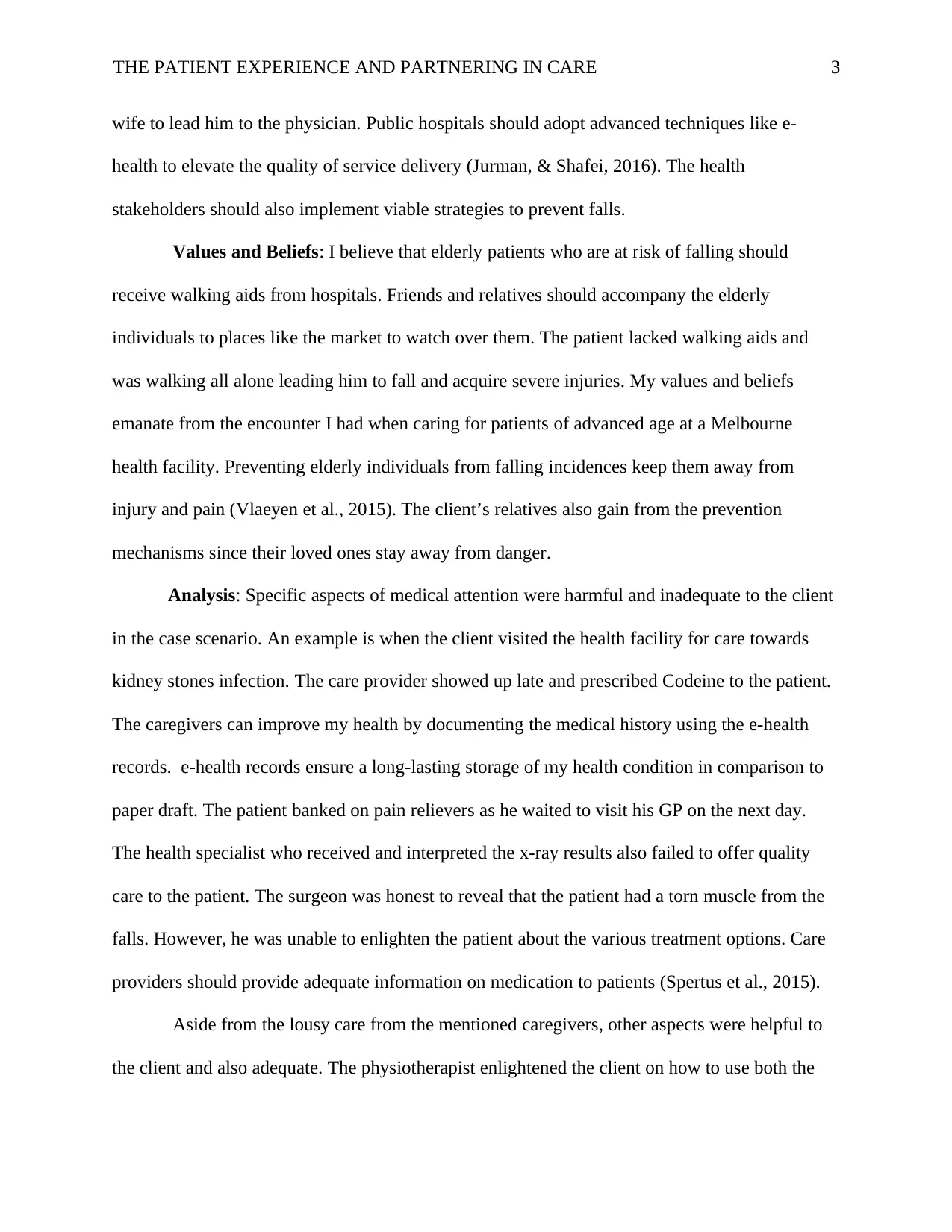
THE PATIENT EXPERIENCE AND PARTNERING IN CARE 3
wife to lead him to the physician. Public hospitals should adopt advanced techniques like e-
health to elevate the quality of service delivery (Jurman, & Shafei, 2016). The health
stakeholders should also implement viable strategies to prevent falls.
Values and Beliefs: I believe that elderly patients who are at risk of falling should
receive walking aids from hospitals. Friends and relatives should accompany the elderly
individuals to places like the market to watch over them. The patient lacked walking aids and
was walking all alone leading him to fall and acquire severe injuries. My values and beliefs
emanate from the encounter I had when caring for patients of advanced age at a Melbourne
health facility. Preventing elderly individuals from falling incidences keep them away from
injury and pain (Vlaeyen et al., 2015). The client’s relatives also gain from the prevention
mechanisms since their loved ones stay away from danger.
Analysis: Specific aspects of medical attention were harmful and inadequate to the client
in the case scenario. An example is when the client visited the health facility for care towards
kidney stones infection. The care provider showed up late and prescribed Codeine to the patient.
The caregivers can improve my health by documenting the medical history using the e-health
records. e-health records ensure a long-lasting storage of my health condition in comparison to
paper draft. The patient banked on pain relievers as he waited to visit his GP on the next day.
The health specialist who received and interpreted the x-ray results also failed to offer quality
care to the patient. The surgeon was honest to reveal that the patient had a torn muscle from the
falls. However, he was unable to enlighten the patient about the various treatment options. Care
providers should provide adequate information on medication to patients (Spertus et al., 2015).
Aside from the lousy care from the mentioned caregivers, other aspects were helpful to
the client and also adequate. The physiotherapist enlightened the client on how to use both the
wife to lead him to the physician. Public hospitals should adopt advanced techniques like e-
health to elevate the quality of service delivery (Jurman, & Shafei, 2016). The health
stakeholders should also implement viable strategies to prevent falls.
Values and Beliefs: I believe that elderly patients who are at risk of falling should
receive walking aids from hospitals. Friends and relatives should accompany the elderly
individuals to places like the market to watch over them. The patient lacked walking aids and
was walking all alone leading him to fall and acquire severe injuries. My values and beliefs
emanate from the encounter I had when caring for patients of advanced age at a Melbourne
health facility. Preventing elderly individuals from falling incidences keep them away from
injury and pain (Vlaeyen et al., 2015). The client’s relatives also gain from the prevention
mechanisms since their loved ones stay away from danger.
Analysis: Specific aspects of medical attention were harmful and inadequate to the client
in the case scenario. An example is when the client visited the health facility for care towards
kidney stones infection. The care provider showed up late and prescribed Codeine to the patient.
The caregivers can improve my health by documenting the medical history using the e-health
records. e-health records ensure a long-lasting storage of my health condition in comparison to
paper draft. The patient banked on pain relievers as he waited to visit his GP on the next day.
The health specialist who received and interpreted the x-ray results also failed to offer quality
care to the patient. The surgeon was honest to reveal that the patient had a torn muscle from the
falls. However, he was unable to enlighten the patient about the various treatment options. Care
providers should provide adequate information on medication to patients (Spertus et al., 2015).
Aside from the lousy care from the mentioned caregivers, other aspects were helpful to
the client and also adequate. The physiotherapist enlightened the client on how to use both the

THE PATIENT EXPERIENCE AND PARTNERING IN CARE 4
healthy and the injured arm. The care provider also issued walking sticks to help the patient in
movement. Moreover, the caregiver explained the physical exercises that could help the patient
to recover from the injuries. The caregiver attending to the anemic situation instructed the client
to take iron tablets. The medications would prevent future falls and balance the patient’s body
structure. The gastroenterologist provided essential care to the patient by asking him to intake the
pill camera. The caregiver recommended the e-health like telemedicine to investigate the cause
of anemia. The diabetes professional suggested Metformin which is an effective drug for
diabetes type two (Powell, Engberg, & Siminerio, 2018). The specialists also prescribed
amlodipine and Indocin to counter hypertension.
Conclusion Drawn: The health facilities in the country have efficient methods of caring
for falls patients. The physiotherapist and the GP offer adequate and helpful care to the patient
after experiencing the two incidences of falls. The patient's encounter with falls indicates that the
accident leaves the victims with severe injuries. The client injured his face, chin, muscles, and
other parts of the body. The senior citizens are at a higher risk of experiencing falls in
comparison to the young individuals. Examples of falls risk factors include industrial deafness,
hypertension, and anemia (Anantharama, Rumantir, Jomon, Ananda-Rajah, & Gilbert, 2016).
Anemia leads to loss of blood; hence interfering with oxygen circulation to various organs. An
anemic individual can fall quickly due to dizziness. An individual with industrial deafness can
easily fall as he cannot hear the sound of approaching objects. Hypertension medications like
amlodipine and Indocin can cause clients to feel dizzy. Therefore, the victims of falls should take
different hypertension medications from the mentioned drugs.
The occurrence of falls affects the affected individuals, friend, and the family (Ferrari,
Santos, & Moça, 2014). In the case scenario, the wife has to abandon her chores to drive the
healthy and the injured arm. The care provider also issued walking sticks to help the patient in
movement. Moreover, the caregiver explained the physical exercises that could help the patient
to recover from the injuries. The caregiver attending to the anemic situation instructed the client
to take iron tablets. The medications would prevent future falls and balance the patient’s body
structure. The gastroenterologist provided essential care to the patient by asking him to intake the
pill camera. The caregiver recommended the e-health like telemedicine to investigate the cause
of anemia. The diabetes professional suggested Metformin which is an effective drug for
diabetes type two (Powell, Engberg, & Siminerio, 2018). The specialists also prescribed
amlodipine and Indocin to counter hypertension.
Conclusion Drawn: The health facilities in the country have efficient methods of caring
for falls patients. The physiotherapist and the GP offer adequate and helpful care to the patient
after experiencing the two incidences of falls. The patient's encounter with falls indicates that the
accident leaves the victims with severe injuries. The client injured his face, chin, muscles, and
other parts of the body. The senior citizens are at a higher risk of experiencing falls in
comparison to the young individuals. Examples of falls risk factors include industrial deafness,
hypertension, and anemia (Anantharama, Rumantir, Jomon, Ananda-Rajah, & Gilbert, 2016).
Anemia leads to loss of blood; hence interfering with oxygen circulation to various organs. An
anemic individual can fall quickly due to dizziness. An individual with industrial deafness can
easily fall as he cannot hear the sound of approaching objects. Hypertension medications like
amlodipine and Indocin can cause clients to feel dizzy. Therefore, the victims of falls should take
different hypertension medications from the mentioned drugs.
The occurrence of falls affects the affected individuals, friend, and the family (Ferrari,
Santos, & Moça, 2014). In the case scenario, the wife has to abandon her chores to drive the
Secure Best Marks with AI Grader
Need help grading? Try our AI Grader for instant feedback on your assignments.
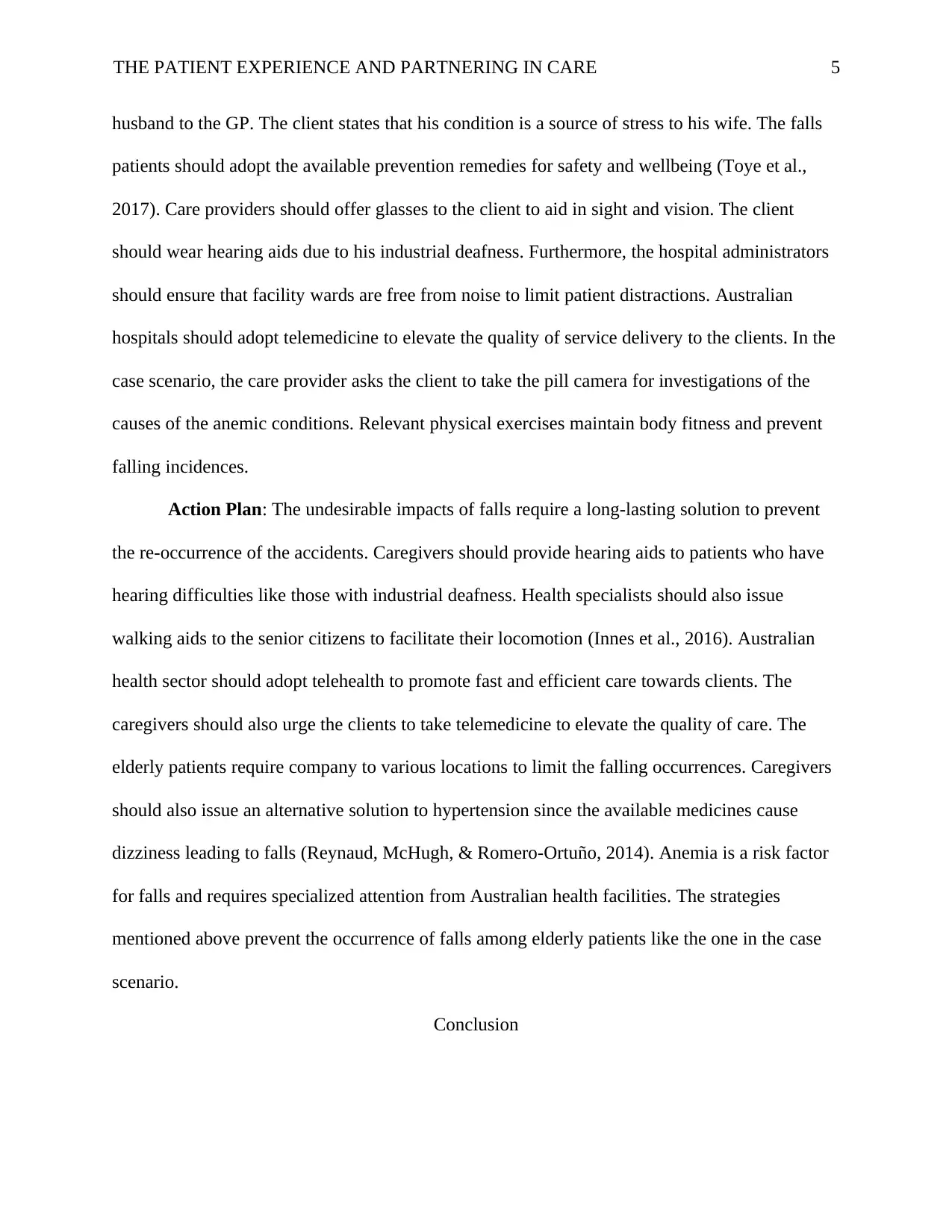
THE PATIENT EXPERIENCE AND PARTNERING IN CARE 5
husband to the GP. The client states that his condition is a source of stress to his wife. The falls
patients should adopt the available prevention remedies for safety and wellbeing (Toye et al.,
2017). Care providers should offer glasses to the client to aid in sight and vision. The client
should wear hearing aids due to his industrial deafness. Furthermore, the hospital administrators
should ensure that facility wards are free from noise to limit patient distractions. Australian
hospitals should adopt telemedicine to elevate the quality of service delivery to the clients. In the
case scenario, the care provider asks the client to take the pill camera for investigations of the
causes of the anemic conditions. Relevant physical exercises maintain body fitness and prevent
falling incidences.
Action Plan: The undesirable impacts of falls require a long-lasting solution to prevent
the re-occurrence of the accidents. Caregivers should provide hearing aids to patients who have
hearing difficulties like those with industrial deafness. Health specialists should also issue
walking aids to the senior citizens to facilitate their locomotion (Innes et al., 2016). Australian
health sector should adopt telehealth to promote fast and efficient care towards clients. The
caregivers should also urge the clients to take telemedicine to elevate the quality of care. The
elderly patients require company to various locations to limit the falling occurrences. Caregivers
should also issue an alternative solution to hypertension since the available medicines cause
dizziness leading to falls (Reynaud, McHugh, & Romero-Ortuño, 2014). Anemia is a risk factor
for falls and requires specialized attention from Australian health facilities. The strategies
mentioned above prevent the occurrence of falls among elderly patients like the one in the case
scenario.
Conclusion
husband to the GP. The client states that his condition is a source of stress to his wife. The falls
patients should adopt the available prevention remedies for safety and wellbeing (Toye et al.,
2017). Care providers should offer glasses to the client to aid in sight and vision. The client
should wear hearing aids due to his industrial deafness. Furthermore, the hospital administrators
should ensure that facility wards are free from noise to limit patient distractions. Australian
hospitals should adopt telemedicine to elevate the quality of service delivery to the clients. In the
case scenario, the care provider asks the client to take the pill camera for investigations of the
causes of the anemic conditions. Relevant physical exercises maintain body fitness and prevent
falling incidences.
Action Plan: The undesirable impacts of falls require a long-lasting solution to prevent
the re-occurrence of the accidents. Caregivers should provide hearing aids to patients who have
hearing difficulties like those with industrial deafness. Health specialists should also issue
walking aids to the senior citizens to facilitate their locomotion (Innes et al., 2016). Australian
health sector should adopt telehealth to promote fast and efficient care towards clients. The
caregivers should also urge the clients to take telemedicine to elevate the quality of care. The
elderly patients require company to various locations to limit the falling occurrences. Caregivers
should also issue an alternative solution to hypertension since the available medicines cause
dizziness leading to falls (Reynaud, McHugh, & Romero-Ortuño, 2014). Anemia is a risk factor
for falls and requires specialized attention from Australian health facilities. The strategies
mentioned above prevent the occurrence of falls among elderly patients like the one in the case
scenario.
Conclusion
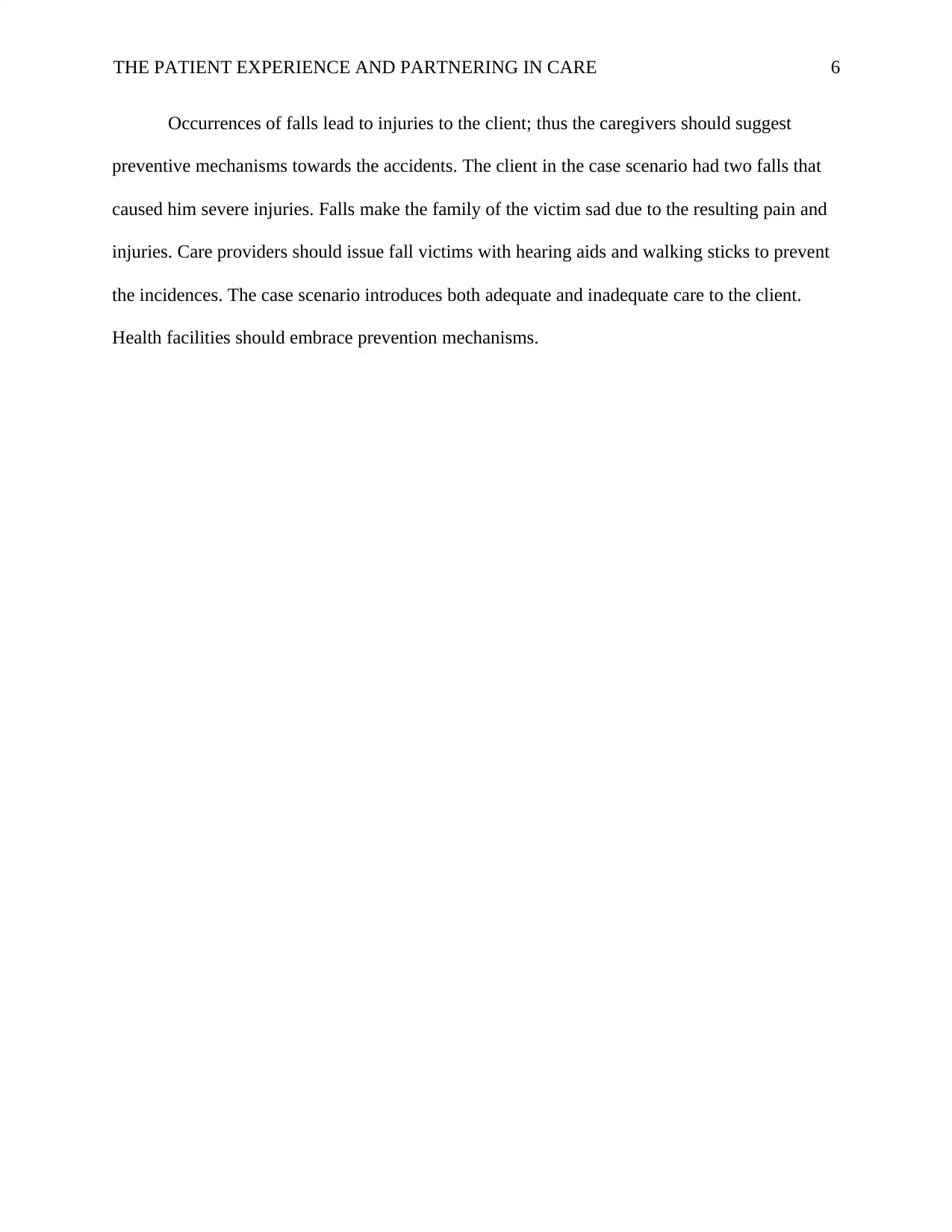
THE PATIENT EXPERIENCE AND PARTNERING IN CARE 6
Occurrences of falls lead to injuries to the client; thus the caregivers should suggest
preventive mechanisms towards the accidents. The client in the case scenario had two falls that
caused him severe injuries. Falls make the family of the victim sad due to the resulting pain and
injuries. Care providers should issue fall victims with hearing aids and walking sticks to prevent
the incidences. The case scenario introduces both adequate and inadequate care to the client.
Health facilities should embrace prevention mechanisms.
Occurrences of falls lead to injuries to the client; thus the caregivers should suggest
preventive mechanisms towards the accidents. The client in the case scenario had two falls that
caused him severe injuries. Falls make the family of the victim sad due to the resulting pain and
injuries. Care providers should issue fall victims with hearing aids and walking sticks to prevent
the incidences. The case scenario introduces both adequate and inadequate care to the client.
Health facilities should embrace prevention mechanisms.
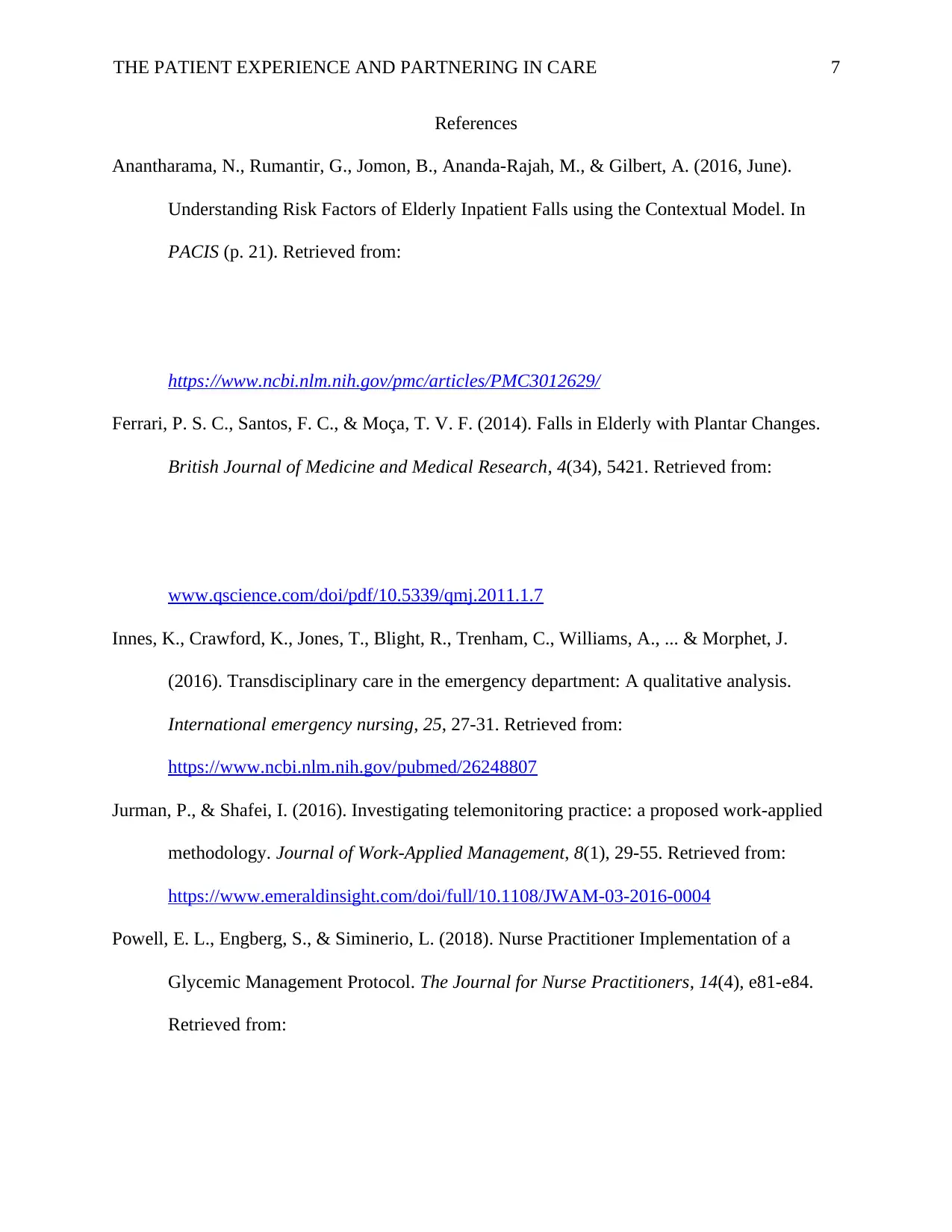
THE PATIENT EXPERIENCE AND PARTNERING IN CARE 7
References
Anantharama, N., Rumantir, G., Jomon, B., Ananda-Rajah, M., & Gilbert, A. (2016, June).
Understanding Risk Factors of Elderly Inpatient Falls using the Contextual Model. In
PACIS (p. 21). Retrieved from:
https://www.ncbi.nlm.nih.gov/pmc/articles/PMC3012629/
Ferrari, P. S. C., Santos, F. C., & Moça, T. V. F. (2014). Falls in Elderly with Plantar Changes.
British Journal of Medicine and Medical Research, 4(34), 5421. Retrieved from:
www.qscience.com/doi/pdf/10.5339/qmj.2011.1.7
Innes, K., Crawford, K., Jones, T., Blight, R., Trenham, C., Williams, A., ... & Morphet, J.
(2016). Transdisciplinary care in the emergency department: A qualitative analysis.
International emergency nursing, 25, 27-31. Retrieved from:
https://www.ncbi.nlm.nih.gov/pubmed/26248807
Jurman, P., & Shafei, I. (2016). Investigating telemonitoring practice: a proposed work-applied
methodology. Journal of Work-Applied Management, 8(1), 29-55. Retrieved from:
https://www.emeraldinsight.com/doi/full/10.1108/JWAM-03-2016-0004
Powell, E. L., Engberg, S., & Siminerio, L. (2018). Nurse Practitioner Implementation of a
Glycemic Management Protocol. The Journal for Nurse Practitioners, 14(4), e81-e84.
Retrieved from:
References
Anantharama, N., Rumantir, G., Jomon, B., Ananda-Rajah, M., & Gilbert, A. (2016, June).
Understanding Risk Factors of Elderly Inpatient Falls using the Contextual Model. In
PACIS (p. 21). Retrieved from:
https://www.ncbi.nlm.nih.gov/pmc/articles/PMC3012629/
Ferrari, P. S. C., Santos, F. C., & Moça, T. V. F. (2014). Falls in Elderly with Plantar Changes.
British Journal of Medicine and Medical Research, 4(34), 5421. Retrieved from:
www.qscience.com/doi/pdf/10.5339/qmj.2011.1.7
Innes, K., Crawford, K., Jones, T., Blight, R., Trenham, C., Williams, A., ... & Morphet, J.
(2016). Transdisciplinary care in the emergency department: A qualitative analysis.
International emergency nursing, 25, 27-31. Retrieved from:
https://www.ncbi.nlm.nih.gov/pubmed/26248807
Jurman, P., & Shafei, I. (2016). Investigating telemonitoring practice: a proposed work-applied
methodology. Journal of Work-Applied Management, 8(1), 29-55. Retrieved from:
https://www.emeraldinsight.com/doi/full/10.1108/JWAM-03-2016-0004
Powell, E. L., Engberg, S., & Siminerio, L. (2018). Nurse Practitioner Implementation of a
Glycemic Management Protocol. The Journal for Nurse Practitioners, 14(4), e81-e84.
Retrieved from:
Paraphrase This Document
Need a fresh take? Get an instant paraphrase of this document with our AI Paraphraser
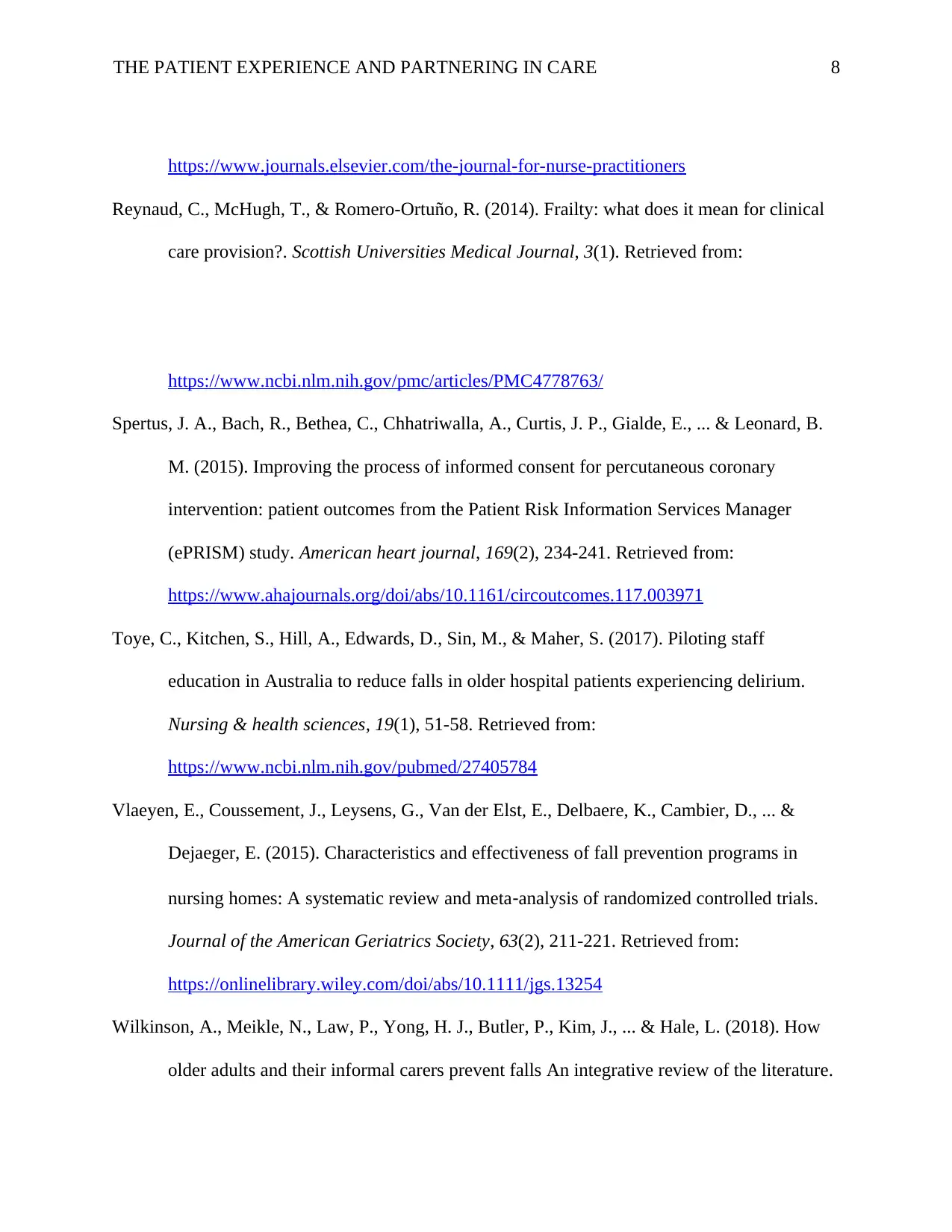
THE PATIENT EXPERIENCE AND PARTNERING IN CARE 8
https://www.journals.elsevier.com/the-journal-for-nurse-practitioners
Reynaud, C., McHugh, T., & Romero-Ortuño, R. (2014). Frailty: what does it mean for clinical
care provision?. Scottish Universities Medical Journal, 3(1). Retrieved from:
https://www.ncbi.nlm.nih.gov/pmc/articles/PMC4778763/
Spertus, J. A., Bach, R., Bethea, C., Chhatriwalla, A., Curtis, J. P., Gialde, E., ... & Leonard, B.
M. (2015). Improving the process of informed consent for percutaneous coronary
intervention: patient outcomes from the Patient Risk Information Services Manager
(ePRISM) study. American heart journal, 169(2), 234-241. Retrieved from:
https://www.ahajournals.org/doi/abs/10.1161/circoutcomes.117.003971
Toye, C., Kitchen, S., Hill, A., Edwards, D., Sin, M., & Maher, S. (2017). Piloting staff
education in Australia to reduce falls in older hospital patients experiencing delirium.
Nursing & health sciences, 19(1), 51-58. Retrieved from:
https://www.ncbi.nlm.nih.gov/pubmed/27405784
Vlaeyen, E., Coussement, J., Leysens, G., Van der Elst, E., Delbaere, K., Cambier, D., ... &
Dejaeger, E. (2015). Characteristics and effectiveness of fall prevention programs in
nursing homes: A systematic review and meta‐analysis of randomized controlled trials.
Journal of the American Geriatrics Society, 63(2), 211-221. Retrieved from:
https://onlinelibrary.wiley.com/doi/abs/10.1111/jgs.13254
Wilkinson, A., Meikle, N., Law, P., Yong, H. J., Butler, P., Kim, J., ... & Hale, L. (2018). How
older adults and their informal carers prevent falls An integrative review of the literature.
https://www.journals.elsevier.com/the-journal-for-nurse-practitioners
Reynaud, C., McHugh, T., & Romero-Ortuño, R. (2014). Frailty: what does it mean for clinical
care provision?. Scottish Universities Medical Journal, 3(1). Retrieved from:
https://www.ncbi.nlm.nih.gov/pmc/articles/PMC4778763/
Spertus, J. A., Bach, R., Bethea, C., Chhatriwalla, A., Curtis, J. P., Gialde, E., ... & Leonard, B.
M. (2015). Improving the process of informed consent for percutaneous coronary
intervention: patient outcomes from the Patient Risk Information Services Manager
(ePRISM) study. American heart journal, 169(2), 234-241. Retrieved from:
https://www.ahajournals.org/doi/abs/10.1161/circoutcomes.117.003971
Toye, C., Kitchen, S., Hill, A., Edwards, D., Sin, M., & Maher, S. (2017). Piloting staff
education in Australia to reduce falls in older hospital patients experiencing delirium.
Nursing & health sciences, 19(1), 51-58. Retrieved from:
https://www.ncbi.nlm.nih.gov/pubmed/27405784
Vlaeyen, E., Coussement, J., Leysens, G., Van der Elst, E., Delbaere, K., Cambier, D., ... &
Dejaeger, E. (2015). Characteristics and effectiveness of fall prevention programs in
nursing homes: A systematic review and meta‐analysis of randomized controlled trials.
Journal of the American Geriatrics Society, 63(2), 211-221. Retrieved from:
https://onlinelibrary.wiley.com/doi/abs/10.1111/jgs.13254
Wilkinson, A., Meikle, N., Law, P., Yong, H. J., Butler, P., Kim, J., ... & Hale, L. (2018). How
older adults and their informal carers prevent falls An integrative review of the literature.
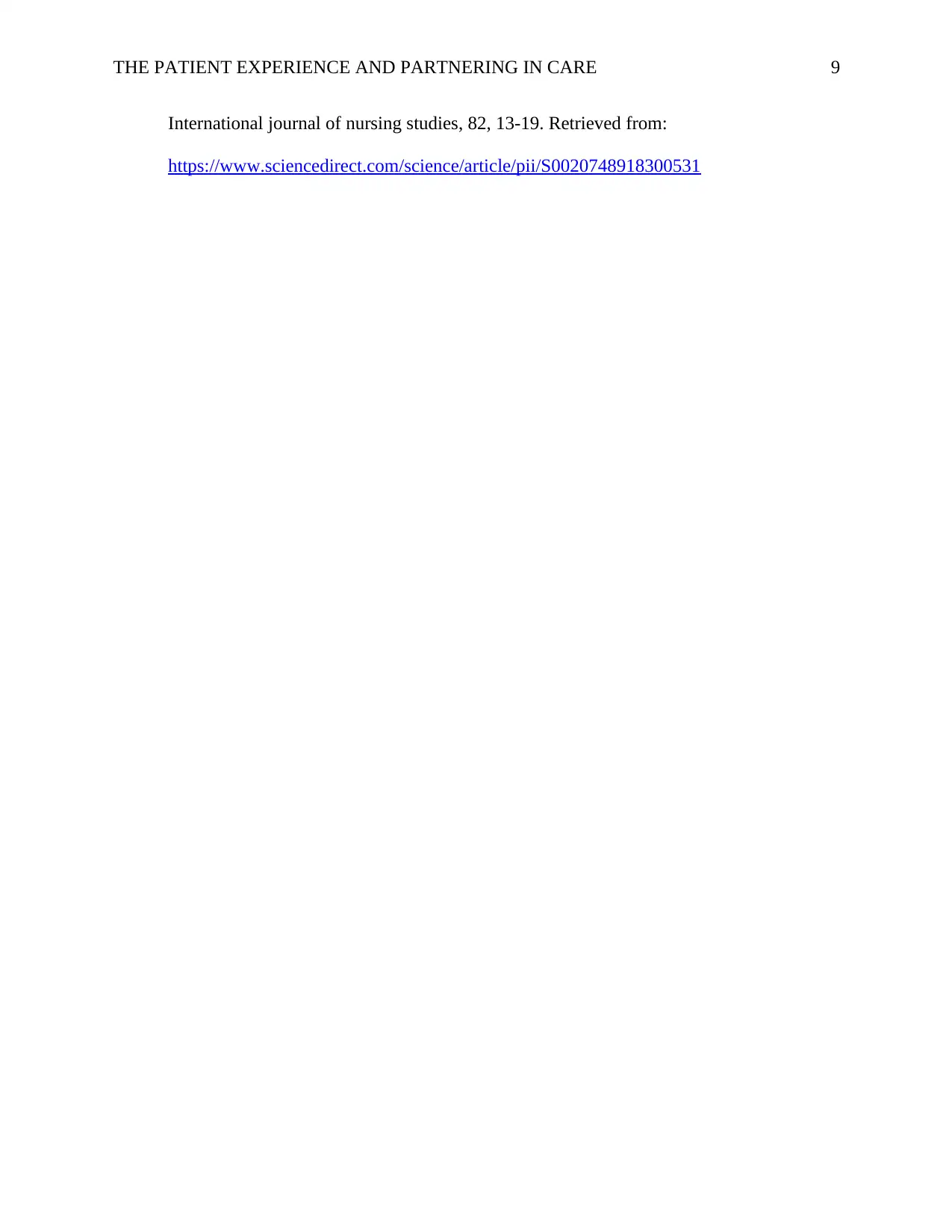
THE PATIENT EXPERIENCE AND PARTNERING IN CARE 9
International journal of nursing studies, 82, 13-19. Retrieved from:
https://www.sciencedirect.com/science/article/pii/S0020748918300531
International journal of nursing studies, 82, 13-19. Retrieved from:
https://www.sciencedirect.com/science/article/pii/S0020748918300531
1 out of 9
Related Documents
Your All-in-One AI-Powered Toolkit for Academic Success.
+13062052269
info@desklib.com
Available 24*7 on WhatsApp / Email
![[object Object]](/_next/static/media/star-bottom.7253800d.svg)
Unlock your academic potential
© 2024 | Zucol Services PVT LTD | All rights reserved.




